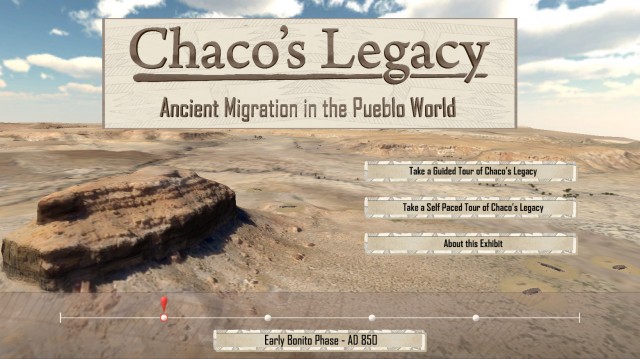- Home
- >
- Press Releases/Announcements
- >
- Chaco’s Legacy
Chaco’s Legacy Offers 3D Vision of an Ancient Pueblo World
Powered by interactive gaming technology, a new touch-screen experience developed by Archaeology Southwest helps heritage tourists explore connections among thousand-year-old pueblos in northwestern New Mexico.

Tucson, AZ (PRWEB) May 29, 2014—Now on display at Aztec Ruins National Monument and Salmon Ruins Museum, Chaco’s Legacy explores the rise and spread of a powerful ancient southwestern Pueblo society from New Mexico’s remote Chaco Canyon. Based in Archaeology Southwest’s latest research, the exhibition provides an intuitive vision of ancient Pueblo landscapes, sites, and artifacts through a virtual-reality game engine, Unity 3D. The National Science Foundation funded development of the exhibition, which will celebrate its grand opening at Bloomfield, New Mexico’s Salmon Ruins Museum on June 5.
Doug Gann and Paul Reed, Preservation Archaeologists with nonprofit Archaeology Southwest, conceived and developed the exhibition, and Gann and independent programmer David Koontz designed the digital infrastructure. That infrastructure ultimately provides archaeologists with a potent tool for sharing findings with the public—Chronological Virtual Reality (CVR). The CVR is a content management system for building interactive exhibits.
“I’ve been developing computerized tools to interpret archaeology for the public for almost three decades,” notes Gann, “but a paradigm shift came when I showed a prototype of this project to David, and he said, ‘Doug, this won’t pass the grandmother test.’” Koontz meant that mimicking the first-person interface of today’s video games as Gann had initially envisioned would create a world that only proficient gamers could negotiate. As a result, Koontz devised a system that enables the less-technologically-savvy to tour ancient places through defined pathways. Each stop on a virtual path can share text, 3D models, audio narration, and—in the interest of promoting public understanding of scientific inquiry and interpretation—dissenting scholarly views.
Through a touch screen, users can tour part of the Chacoan world through time and across space, interactively exploring eight monumental pueblos, several small villages, some pueblo room interiors, two ceremonial spaces, and hundreds of ancient objects, all dating between about A.D. 850 and 1200. The Chacoan landscape users navigate is a photorealistic digital model generated from photographs taken especially for the project by noted aerial photographer Adriel Heisey. Gann, fellow digital archaeologist Aaryn Brewer, and intern Brian Crosby created the 3D reconstructions of architecture and objects through a photogrammetric process on actual museum collections and by poring over nearly a century’s worth of published archaeological data.
Zuni cultural consultant Dan Simplicio enriched Chaco’s Legacy through his knowledge and guidance, challenging the team to create something that would not only serve as an education and preservation tool, but also help users appreciate the continuity among past, present, and future for Native peoples. “The [CVR] system behind the exhibit can help people achieve a partial understanding of the past while protecting esoteric aspects that are private and exclusive to indigenous people,” affirms Simplicio. “Overall, it’s achieving what we hoped for—the re-creation of an ancient landscape and lifeway. Now, Native people can offer critical input that will help convey what it all means.”
For Archaeology Southwest, the Chaco’s Legacy experience and the forthcoming release of the CVR as an open-source tool are central to its mission to explore and protect the places of the past. “I hope that the experiences realized through the CVR raise people’s awareness of where they fit in a 12,000-year continuum of life in the Southwest—and the whole of human history, globally,” says President and CEO Bill Doelle. “When people find a meaningful connection to those who came before, they become better stewards of the places and traces of the past.” Reed, who lives in northwestern New Mexico, adds, “I want people to know some of the stories of this fragile Chacoan landscape I love, which may be obliterated if it opens to oil and gas extraction through fracking, as planned.”
Chaco’s Legacy celebrates its grand opening on Thursday, June 5, 2014, 6:00–8:00 p.m., at Salmon Ruins Museum, 6131 Highway 64, Bloomfield, NM. Chaco’s Legacy is also on display at Aztec Ruins National Monument, 84 County Road 2900 (“Ruins Road”), Aztec, NM.
Evaluation copies of Chaco’s Legacy are available for download and professional review. Email Douglas Gann to learn more.
About Archaeology Southwest
Archaeology Southwest is a private 501(c)(3) nonprofit organization based in Tucson, Arizona, that explores and protects the places of our past across the American Southwest and Mexican Northwest. For three decades, Archaeology Southwest has practiced a holistic, conservation-based approach known as Preservation Archaeology. By exploring what makes a place special, sharing this knowledge in innovative ways, and enacting flexible site protection strategies, we foster meaningful connections to the past and respectfully safeguard its irreplaceable resources. Learn more at https://www.archaeologysouthwest.org.
###
One thought on “Chaco’s Legacy”
Comments are closed.
Explore the News
-
Join Today
Keep up with the latest discoveries in southwestern archaeology. Join today, and receive Archaeology Southwest Magazine, among other member benefits.
I’ve been looking for 3D or Virtual Reality (VR) representations of Chaco Canyon. This looks really interesting, but my ability to travel to see it is, well, simply not going to happen. Closest I’ve found is “Anasazi of Chaco Canyon” at https://chaco-canyon.com.